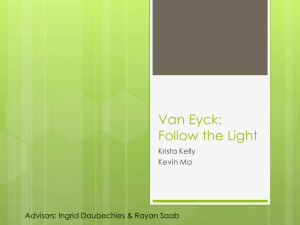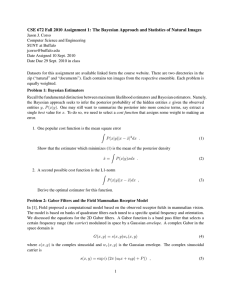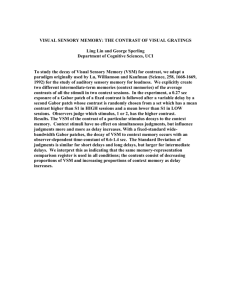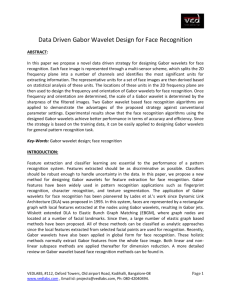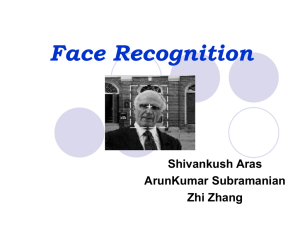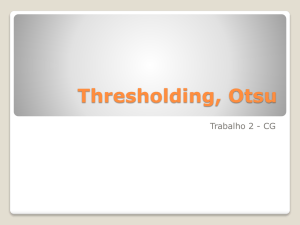Gabor Wavelet Based Features Extraction for RGB Objects Recognition Using Fuzzy Classifier
advertisement
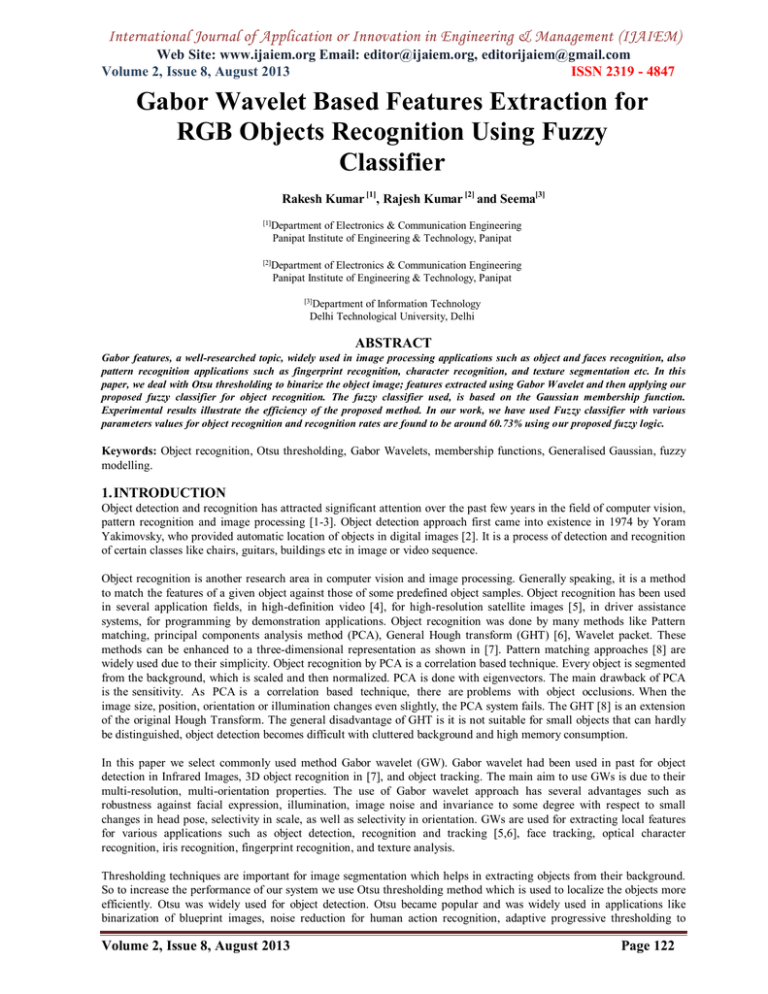
International Journal of Application or Innovation in Engineering & Management (IJAIEM)
Web Site: www.ijaiem.org Email: editor@ijaiem.org, editorijaiem@gmail.com
Volume 2, Issue 8, August 2013
ISSN 2319 - 4847
Gabor Wavelet Based Features Extraction for
RGB Objects Recognition Using Fuzzy
Classifier
Rakesh Kumar [1], Rajesh Kumar [2] and Seema[3]
[1]
Department of Electronics & Communication Engineering
Panipat Institute of Engineering & Technology, Panipat
[2]
Department of Electronics & Communication Engineering
Panipat Institute of Engineering & Technology, Panipat
[3]
Department of Information Technology
Delhi Technological University, Delhi
ABSTRACT
Gabor features, a well-researched topic, widely used in image processing applications such as object and faces recognition, also
pattern recognition applications such as fingerprint recognition, character recognition, and texture segmentation etc. In this
paper, we deal with Otsu thresholding to binarize the object image; features extracted using Gabor Wavelet and then applying our
proposed fuzzy classifier for object recognition. The fuzzy classifier used, is based on the Gaussian membership function.
Experimental results illustrate the efficiency of the proposed method. In our work, we have used Fuzzy classifier with various
parameters values for object recognition and recognition rates are found to be around 60.73% using our proposed fuzzy logic.
Keywords: Object recognition, Otsu thresholding, Gabor Wavelets, membership functions, Generalised Gaussian, fuzzy
modelling.
1. INTRODUCTION
Object detection and recognition has attracted significant attention over the past few years in the field of computer vision,
pattern recognition and image processing [1-3]. Object detection approach first came into existence in 1974 by Yoram
Yakimovsky, who provided automatic location of objects in digital images [2]. It is a process of detection and recognition
of certain classes like chairs, guitars, buildings etc in image or video sequence.
Object recognition is another research area in computer vision and image processing. Generally speaking, it is a method
to match the features of a given object against those of some predefined object samples. Object recognition has been used
in several application fields, in high-definition video [4], for high-resolution satellite images [5], in driver assistance
systems, for programming by demonstration applications. Object recognition was done by many methods like Pattern
matching, principal components analysis method (PCA), General Hough transform (GHT) [6], Wavelet packet. These
methods can be enhanced to a three-dimensional representation as shown in [7]. Pattern matching approaches [8] are
widely used due to their simplicity. Object recognition by PCA is a correlation based technique. Every object is segmented
from the background, which is scaled and then normalized. PCA is done with eigenvectors. The main drawback of PCA
is the sensitivity. As PCA is a correlation based technique, there are problems with object occlusions. When the
image size, position, orientation or illumination changes even slightly, the PCA system fails. The GHT [8] is an extension
of the original Hough Transform. The general disadvantage of GHT is it is not suitable for small objects that can hardly
be distinguished, object detection becomes difficult with cluttered background and high memory consumption.
In this paper we select commonly used method Gabor wavelet (GW). Gabor wavelet had been used in past for object
detection in Infrared Images, 3D object recognition in [7], and object tracking. The main aim to use GWs is due to their
multi-resolution, multi-orientation properties. The use of Gabor wavelet approach has several advantages such as
robustness against facial expression, illumination, image noise and invariance to some degree with respect to small
changes in head pose, selectivity in scale, as well as selectivity in orientation. GWs are used for extracting local features
for various applications such as object detection, recognition and tracking [5,6], face tracking, optical character
recognition, iris recognition, fingerprint recognition, and texture analysis.
Thresholding techniques are important for image segmentation which helps in extracting objects from their background.
So to increase the performance of our system we use Otsu thresholding method which is used to localize the objects more
efficiently. Otsu was widely used for object detection. Otsu became popular and was widely used in applications like
binarization of blueprint images, noise reduction for human action recognition, adaptive progressive thresholding to
Volume 2, Issue 8, August 2013
Page 122
International Journal of Application or Innovation in Engineering & Management (IJAIEM)
Web Site: www.ijaiem.org Email: editor@ijaiem.org, editorijaiem@gmail.com
Volume 2, Issue 8, August 2013
ISSN 2319 - 4847
segment lumen regions from endoscopic images, segmentation of moving lips for speech recognition, edge detection and
Colour Image Segmentation.
Gabor Wavelet and Otsu thresholding together came into existence in 2000 where Gabor wavelets was used to reduce the
redundancy in the wavelet-based representation and Otsu’s method of thresholding was used to reconstruct the magnitude
and phase of the directional components of the image It uses GW and Otsu for vessel segmentation in retinal images. In
all these researches first GW is applied then thresholded by Otsu method.
For recognition many different classifiers have been employed over the years like KNN, Neural Network (NN), GMM,
HMM, SVM, LDA. In this research work we used fuzzy classifier which uses GW features obtained from Otsu
thresholded image. In the past, similar work has been carried out for the recognition of handwritten character recognition
[4]. The model presented in this paper is effectively used to achieve computationally efficient object recognition under a
wide range of conditions shown in Figure 1.
Figure 1: Proposed model for Object Recognition
The organization of this paper is as follows. Section 2 describes how GW with Otsu is used for feature extraction.
Recognition System is briefly described in Section 3. Section 4 will present the results and the conclusions are given in
Section 5.
2. FEATURE EXTRACTION
In this section, we describe the feature extraction process. On the line of work done by [7] we adopt Otsu and GW to
recognize the objects. The difference in our approach is that we first apply Otsu thresholding and then Gabor Wavelet.
The feature extraction includes two stages: first using Otsu thresholding then applying Gabor filter.
Otsu method is a popular method in computer vision and image processing, used to automatically calculate the
thresholding level with which a gray level image is reduced to a binary image[9]. The algorithm assumes that the image
to be thresholded contains two classes of pixels (e.g. foreground and background) then calculates the optimum threshold
separating those two classes so that their combined spread (intra-class variance) is minimal.
Gabor Wavelets (GWs) with good characteristics of space-frequency localization are commonly used for extracting local
features for various applications like object detection, recognition and tracking. The Gabor wavelet representation of an
image is the convolution of the image with a family of Gabor Wavelets [10]. Gabor wavelets detect the edge detector, face
region and facial features regions. GWs use Gabor functions which was first proposed in 1946 by Dennis Gabor [8].
Gabor transform is the short-time Fourier transform, used to determine the sinusoidal frequency and phase content of a
signal which changes with time [13]. A complex Gabor filter is defined as the product of a Gaussian kernel times a
complex sinusoid which is then transformed with a Fourier transform to derive the time-frequency analysis and is defined
as [6]:
Where
is a complex plane wave and
is a term compensates for the DC value which makes the kernel DCfree [14]. The parameter z = (x, y) indicates a point with horizontal and vertical coordinate of image obtained after Otsu
thresholding. The operator
denotes the norm operator. Parameters u and ν defines the angular orientation and the
spatial frequency of the Gabor kernel where ν determines scale of kernel. The standard deviation of Gaussian
window
. The wave vector
is
Where
with u ∈ {0... 3} if four different orientations are chosen. The maximum frequency
and the spatial factor f = √2 with ν
Volume 2, Issue 8, August 2013
{0, 3} if four different scales are chosen.
Page 123
International Journal of Application or Innovation in Engineering & Management (IJAIEM)
Web Site: www.ijaiem.org Email: editor@ijaiem.org, editorijaiem@gmail.com
Volume 2, Issue 8, August 2013
ISSN 2319 - 4847
Figure 2: Flowchart for feature extraction stages of Object Image
To extract the features from images using GW following steps are carried out (shown in Figure 2 for Single component
i.e. R, similarly it can be done for G and B):
Step 1: First reducing the size of an RGB input image to 40×40×3. This step is done to reduce the size of feature matrix
obtained for training.
Step 2: Otsu threshold method is applied as a pre-processing step in order to remove noise and binarize the image. That
is, Otsu thresholding is applied on each component (R,G,B components) separately.
Step 3: Gabor Wavelet filter is created and the parameters for Gabor wavelet are set as Gabor kernel size is taken as
24*24, orientations 0, π/4, π/2, 3π/4 and scales 0,1,2,3. The Kernel size is not taken smaller or larger than image size so
that appropriate information can be determined.
Step 4: As described above Gabor filter contains real and imaginary parts. So kernel designed is composed of real and
imaginary parts with 4 orientations and 4 scales.
Step 5: Then convolving the image’s each component with 16 Gabor wavelets i.e. with real and imaginary part of Gabor
filter separately and obtaining 16 real and 16 imaginary responses respectively corresponding from each component (R,
G, B).
Step 6: After that calculating 16 magnitude responses using real and imaginary responses obtained from step 5
corresponding to each component (R, G, B).
Step 7: Repeat the above steps for all the images. So feature vector of size 25600×3 [(4×4×40×40) × 3 where 3 is due to 3
components i.e. R,G,B] containing magnitude response corresponding to each image is obtained.
3. RECOGNITION
Fuzzy Logic is used to recognize objects, which was initiated in 1965, by Dr. Lotfi A. Zadeh. Basically, Fuzzy Logic is a
multi-valued logic, which allows intermediate values to be defined between conventional evaluations like true/false,
yes/no, high/low, etc.
Fuzzy classification is the process of grouping elements into a fuzzy set which allows its members to have
different grades of membership (membership function) in the interval [0, 1]. In our work we proposed a new classifier
using Gaussian fuzzy membership function which is as follows:
Where a and b represents the variables whose values obtained experimentally explained later on. So by varying the values
of a = 0.25, 0.5,1 and fixing the value of b = 2 (by popular choice), we obtain best results for a =1 xi denotes ith feature of
test image and ui denotes corresponding ith feature of sth input image sample respectively, so i denotes the features with i
=1 to 25600 and s denotes sample object images with s = 1 to 100.
Volume 2, Issue 8, August 2013
Page 124
International Journal of Application or Innovation in Engineering & Management (IJAIEM)
Web Site: www.ijaiem.org Email: editor@ijaiem.org, editorijaiem@gmail.com
Volume 2, Issue 8, August 2013
ISSN 2319 - 4847
We used Gaussian fuzzy membership function for our features as
for each i value where i represents the features with a range from 1 to 25600 on each feature of test object image and
corresponding feature of every input image. Summation of all the features is used which takes algebraic sum of all the
features. So summation for generalization of logical conjunction, for fuzzy logics is used as follows:
In our real life we deal with colour images so we have used colour images for testing and training. That is for RGB
training and RGB testing dataset, we obtain our feature vector as explained above. So obtaining feature matrix for each
image of size 25600×3. This way we obtain the feature matrix for training and testing image samples. So finally size of
our RGB Training dataset is 25600×3×150 (as we trained with 150 images) and that for RGB Testing dataset is
25600×3×494 (as we used 494 images for testing).
Recognition is the process of classifying objects to the trained object classes having the similar characteristics. We have
used Gaussian membership function μ, for classification explained as under. Repeat all steps for every test samples:
Step 1: Each test sample is comprised of 3 channels (RGB). Using each feature value in every channel, find the degree of
membership to corresponding channel of training object class using the corresponding feature values from every object
samples using equation (4)&(5) as follows:
for each j value where j represents three channels and i represents the features where i = 1 to 25600.
Step 2: Select that channel’s membership value corresponding to each training object class samples whose degree of
membership value, , is the maximum amongst object class samples.
Step 3: Assign the test sample to that training object class sample which has maximum degree of membership value, µ
amongst all.
Step 4: Finally, each test sample is classified to the most appropriate training object class. As in last step test sample was
assigned object class sample, in this step we check to which object class that object class sample belongs to
4. EXPERIMENTAL RESULTS
In this section, we present the images database [8] which is used in our research. The experimental work is performed on
object samples taken from the Caltech dataset. The Caltech 101 dataset consists of images of various objects. It contains a
total of 9146 images of objects belonging to 101 categories (including faces, watches, pianos, chairs, guitars, etc). It is
intended to facilitate Computer Vision research and techniques. It is most applicable to techniques interested in
recognition, classification, and categorization.
In our paper we have compared the results obtained after classification from Fuzzy classifier Gray Images, Gray Images
with Otsu thresholded, RGB images, and RGB images thresholded with Otsu, the results are shown in Table I
respectively, which shows results obtained from fuzzy classifier with a = 1,b=2 are better compare to other classifiers.
So in our research work we have included 10 different objects classes with all the samples present in Caltech dataset for
these 10 classes. From all samples,15 samples have been used for training and remaining samples for testing
corresponding to each object class. We have included objects classes such as Butterfly, Ketch, Garfield, Gramophone,
Electric Guitar, Hedgehog, Mandolin, Menorah, Panda, and Pyramid. and their corresponding images for some object
classes can be seen in Figure 3.
Volume 2, Issue 8, August 2013
Page 125
International Journal of Application or Innovation in Engineering & Management (IJAIEM)
Web Site: www.ijaiem.org Email: editor@ijaiem.org, editorijaiem@gmail.com
Volume 2, Issue 8, August 2013
ISSN 2319 - 4847
In Figure 3 we have also shown their corresponding results i.e. Thresholded image (obtained after Otsu thresholding) and
Gabor features image (which is a magnitude response and is obtained after applying Gabor wavelet).
Results of our proposed classifier can be seen in last column of Table I. These results have been compared with gray
training and gray testing, RGB training and RGB testing, Gray otsu training and testing, RGB otsu Training and Testing.
With our proposed approach we are able to obtain 60.73% Recognition Rate or we can say 60.73% of test objects were
correctly classified as shown in Table I. It can be seen that our proposed system gives highest performance in comparison
to other systems. It just takes approx. 4 sec for each sample to get classify.
Figure 3: Object Classes and Their Corresponding Images i.e. Object Image, Thresholded Image (obtained from Otsu
thresholding), and Magnitude Response Image of size 25600*1 (which are Gabor features obtained after applying Gabor
wavelet). These results obtained are used for training. We have included objects: (a) Butterfly, (b) Ketch, (c) Garfield,(d)
Gramophone, (e) Electric Guitar, (f) Hedgehog, (g) Mandolin, (h)Menorah, (i) Panda, and (j) Pyramid with their
corresponding images.
Table 1: Comparison of Gray Training and Testing, RGB Training and Testing, Gray -Otsu Training and Testing RGBOtsu Training and Testing
S
No.
1
2
3
4
5
6
7
8
9
10
Name
Butterfly
Garfield
Gramophone
Electric guitar
Hedgehog
Ketch
Mandolin
Menorah
Panda
Pyramid
Total
Average in
%age
Total
Image
per
Class
(for
Test)
76
19
36
60
39
99
28
72
23
42
494
Gray Training
and Testing
RGB Training
and Testing
Gray -Otsu
Training and
Testing
RGB-Otsu
Training
and Testing
( %age Correctly Classified) using Fuzzy Classifier ; where a = 1 and b = 2
23.68
26.31
0.25
23.33
25.64
46.46
35.71
72.22
13.04
66.66
195
40.79
26.32
19.44
16.67
25.64
60.61
32.14
63.89
43.48
64.29
215
60.53
42.11
38.89
53.33
48.72
66.67
60.71
69.44
17.39
64.29
283
64.47
52.63
47.22
51.67
43.59
75.76
67.86
58.33
26.09
80.95
300.01
39.47
43.52
57.29
60.73
5. CONCLUSION
The proposed system for object recognition which is based on recognition of Otsu with Gabor features thresholding of
RGB using proposed fuzzy classifier works well. We can also see the percent of misclassified objects as:
=
Volume 2, Issue 8, August 2013
Page 126
International Journal of Application or Innovation in Engineering & Management (IJAIEM)
Web Site: www.ijaiem.org Email: editor@ijaiem.org, editorijaiem@gmail.com
Volume 2, Issue 8, August 2013
ISSN 2319 - 4847
In our work, same experiments were performed with GW features using fuzzy classifiers. Consequently the misclassified
samples were calculated according to classification. Using Gray Training and Gray Testing by Fuzzy Classifier 60.53%
respectively. After considering RGB Training and RGB testing the misclassification of samples rate was 56.48% using
fuzzy Classifier also. For having better performance Otsu thresholding implemented with Gray Training and Gray testing
and the rate of misclassified samples was 42.71 for Fuzzy classifier. Thereafter Otsu thresholding has been implemented
on RGB training and RGB testing for improving the classification rate of RGB training and RGB testing so Otsu RGB
has misclassification rate using fuzzy classifier only 39.27% samples respectively were wrongly classified.
In effect, we may say that our proposed system gives highest performance in comparison to other systems. Experimental
results show that the proposed method performs better than other approaches in terms of both efficiency and accuracy.
REFERENCES:
[1] Roach, J. W.; Aggarwal, J. K., “Computer Tracking of Objects Moving in Space”, Pattern Analysis and Machine
Intelligence, IEEE Transactions on Volume: PAMI-1 , Issue: 2, Year: 1979 , Page(s): 127 – 135.
[2] Yoram Yakimovsky, “Boundary and object detection in real world images”, Decision and Control including the 13th
Symposium on Adaptive Processes, 1974 IEEE Conference on Volume: 13, Part: 1
[3] N. E. Nahi, S. Lopez-Mora, “Estimation of object boundaries in noisy images”, Decision and Control including the
15th Symposium on Adaptive Processes, 1976 IEEE Conference on Volume: 15 , Part: 1
[4] Rolf P. Würtz, “Object Recognition Robust under Translations, Deformations, and Changes in Background”, IEEE
Trans on Pattern Analysis and Machine Intelligence, pages 769–799, July 1997.
[5] Xing Wu and Bir Bhanu, Fellow, IEEE, “Gabor Wavelet Representation for 3-D Object Recognition”, IEEE
Transactions On Image Processing, Vol. 6, No. 1, January 1997.
[6] D. Gabor, “Theory of communication”, Journal of Institute of Electrical Engineers, vol. 93, pp.429-457, 1946.
[7] N.Otsu, A threshold selection method from gray level histograms, IEEE SMC-9, page 62-66, Jan 1979.
[8] http://www.vision.caltech.edu/Image_Datasets/ Caltech101/Caltech101.html.
[9] Linlin Shen and Li Bai, “A review on Gabor wavelets for face recognition”, Pattern Analysis Application, Volume 9,
Numbers 2-3, 273-292, August 2006.
[10] F. Dornaika, F. Chakik; "Efficient Object Detection and Matching Using Feature Classification "; IEEE Conference
Pattern Recognition (ICPR), 2010 20th International Conference; page(s): 3073 - 3076; 2010.
[11] Li He, Hui Wang, Hong Zhang; "Object detection by parts using appearance, structural and shape features"; IEEE
Conference Mechatronics and Automation(ICMA), 2011 International Conference; page(s): 489 - 494 ; 2011.
[12] Zhang Xiaoyan, Liu Lingxia, Zhuang Xuchun; "An automatic video object segmentation scheme "; IEEE Conference
Intelligent Signal Processing and Communication Systems, 2007 (ISPACS), 2007 International Symposium; page(s):
272 - 275; 2007.
[13] Mei Han, A. Sethi, Wei Hua, Yihong Gong; "A detection-based multiple object tracking method"; IEEE Conference
Image Processing, 2004 (ICIP '04); volume:5; page(s): 3065 - 3068; 2004.
[14] R.N. Strickland, He Il Hahn; "Wavelet transform methods for object detection and recovery"; Image Processing,
IEEE Transactions; volume: 6; issue: 5; page(s): 724 - 735; 1997.
[15] T. Modegi; "Small object recognition techniques based on structured template matching for high-resolution satellite
images"; SICE Annual Conference, 2008, IEEE; page(s): 2168 - 2173; 2008.
Volume 2, Issue 8, August 2013
Page 127
